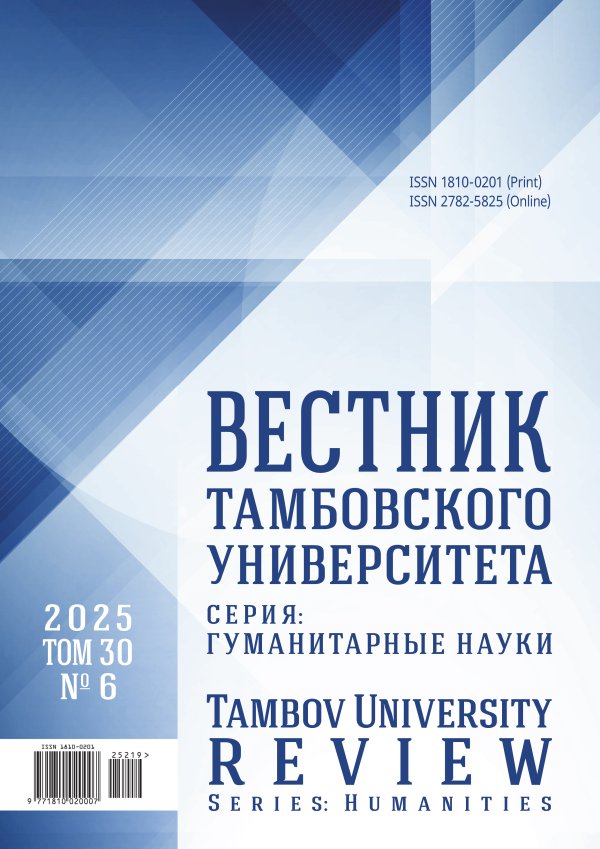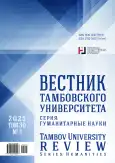Обучение студентов иноязычному общению посредством технологий искусственного интеллекта
- Авторы: Прибыткова А.А.1, Рязанцева Т.Ю.2, Хаустов О.Н.2
-
Учреждения:
- ФГБОУ ВО «Липецкий государственный педагогический университет им. П.П. Семенова-Тян-Шанского»
- ФГБОУ ВО «Липецкий государственный технический университет»
- Выпуск: Том 30, № 1 (2025)
- Страницы: 94-106
- Раздел: ТЕОРИЯ И МЕТОДИКА ОБУЧЕНИЯ ИНОСТРАННОМУ ЯЗЫКУ
- URL: https://bakhtiniada.ru/1810-0201/article/view/297481
- DOI: https://doi.org/10.20310/1810-0201-2025-30-1-94-106
- ID: 297481
Цитировать
Аннотация
Актуальность. Инструменты искусственного интеллекта (ИИ) обладают значительным лингводидактическим потенциалом, позволяющим их интегрировать в процесс обучения иностранному языку с целью формирования аспектов иностранного языка и развития видов иноязычной речевой деятельности. Однако, несмотря на наличие поэтапных методик обучения иностранному языку на основе ИИ, большая их часть ориентирована на формирование лексико-грамматических навыков речи и развитие умений письменной монологической речи учащихся и студентов. Разработка методики обучения студентов языкового вуза иноязычному речевому общению посредством практики с инструментом ИИ не выступала предметом отдельного исследования. Цель исследования – разработка методики обучения студентов языкового вуза иноязычному общению посредством практики с инструментом ИИ и проверка ее эффективности в ходе экспериментального обучения.
Материалы и методы. Участниками обучения выступили студенты 2 курсов направления подготовки «Лингвистика» («Теория и методика преподавания иностранных языков и культур») (ЛГПУ) и специальности «Перевод и переводоведение» (ЛГТУ). В контрольной группе (КГ) (N = 24) обучение проходило по традиционной методике обучения без практики студентов с инструментом ИИ. В экспериментальной группе (ЭГ) (N = 24) наряду с аудиторными занятиями студенты принимали участие в учебном общении на иностранном языке с виртуальными собеседниками на платформе Character.AI. Аспектами контроля выступили 16 умений (восприятия, продукции и взаимодействия) речевого общения. Для статистической обработки данных использовался t-критерий Стьюдента.
Результаты исследования. Проведенное экспериментальное исследование в целом доказало эффективность авторской методики обучения студентов языкового вуза иноязычному общению посредством технологий искусственного интеллекта: выражать свою точку зрения по обсуждаемому вопросу (t = 1,44 при р = 0,08), аргументировать согласие или несогласие по обсуждаемому вопросу (t = 1,44 при р = 0,08) и следовать очередности в общении. Полученные данные показывают, что практика студентов с виртуальным собеседником не оказала особого влияния на развитие первых двух умений. Относительно высокие показатели констатирующего среза по данным аспектам контроля (умение 2.3: КГ: 𝑥̅ = 4,25; ЭГ: 𝑥̅ = 4,29; умение 2.4: КГ: 𝑥̅ = 4,00; ЭГ: 𝑥̅ = 4,04) свидетельствуют о том, что данные умения были развиты у большинства студентов на 1 курсе вуза или в старших классах общеобразовательной школы.
Выводы. Новизна проведенного исследования заключена в разработке авторской методики обучения студентов языкового вуза иноязычному речевому общению посредством практики с инструментом ИИ (Character.AI). Предлагаемая методика может быть использована в средней общеобразовательной школе и языковых и неязыковых вузах.
Об авторах
А. А. Прибыткова
ФГБОУ ВО «Липецкий государственный педагогический университет им. П.П. Семенова-Тян-Шанского»
Email: Anechka86@mail.ru
ORCID iD: 0000-0003-2561-6656
кандидат педагогических наук, доцент кафедры лингвистики и межкультурной коммуникации
Россия, 398020, Российская Федерация, г. Липецк, ул. Ленина, 42Т. Ю. Рязанцева
ФГБОУ ВО «Липецкий государственный технический университет»
Email: tchetvernina75@mail.ru
ORCID iD: 0000-0002-1846-9128
кандидат педагогических наук, доцент кафедры иностранных языков
Россия, 398042, Российская Федерация, г. Липецк, ул. Московская, 30О. Н. Хаустов
ФГБОУ ВО «Липецкий государственный технический университет»
Автор, ответственный за переписку.
Email: o.khaustov@mail.ru
ORCID iD: 0009-0002-6947-4397
кандидат педагогических наук, доцент кафедры иностранных языков
Россия, 398042, Российская Федерация, г. Липецк, ул. Московская, 30Список литературы
- Барышников Н.В. Параметры обучения межкультурной коммуникации в средней школе // Иностранные языки в школе. 2002. № 2. С. 28-32. https://elibrary.ru/tifilx
- Сысоев П.В. Пересматривая конструкт межкультурной компетенции: обучение межкультурному взаимо-действию в условиях «диалога культур» и «не-диалога культур» // Язык и культура. 2018. № 43. С. 261-281. https://doi.org/10.17223/19996195/43/16, https://elibrary.ru/ytuqmp
- Park J. An AI-based English grammar checker vs. human raters in evaluating EFL learners’ writing // Multi-media-Assisted Language Learning. 2019. Vol. 22. № 1. P. 112-131. https://doi.org/10.15702/mall.2019.22.1.112
- Perdana I., Farida M. Online grammar checkers and their use for EFL writing // Journal of English Teaching, Applied Linguistics, and Literatures. 2019. Vol. 2. № 2. P. 67-76. https://doi.org/10.20527/jetall.v2i2.7332
- Dembsey J.M. Closing the Grammarly gaps: a study of claims and feedback from an online grammar program // Writing Center Journal. 2017. Vol. 36. Issue 1. P. 63-100. https://doi.org/10.7771/2832-9414.1815
- Ghufron M.A., Rosyida F. The role of Grammarly in assessing English as a foreign language (EFL) writing // Lingua Cultura. 2018. Vol. 12. № 4. P. 395-403. https://doi.org/10.21512/lc.v12i4.4582
- Jayavalan K., Razali A.B. Effectiveness of online grammar checker to improve secondary students’ English narrative essay writing // International Research Journal of Education and Sciences. 2018. Vol. 2. № 1. P. 1-6. http://doi.org/10.15738/kjell.18.3.201809.328
- Manap M.R., Ramli N.F., Kassim A.A.M. Web 2.0 automated essay scoring application and human ESL essay assessment: a comparison study // European Journal of English Language Teaching. 2019. Vol. 5. № 1. P. 146-162. http://doi.org/10.5281/zenodo.3461784
- Wang J., Brown M.S. Automated essay scoring versus human scoring: a comparative study // Journal of Tech-nology, Learning, and Assessment. 2007. Vol. 6. № 2. P. 1-29.
- Zhang M. Contrasting automated and human scoring of essays // R&D Connections. 2013. Vol. 21. P. 1-11.
- Guo K., Wang D. To resist it or to embrace it? Examining ChatGPT’s potential to support teacher feedback in EFL writing // Education and Information Technologies. 2023. Vol. 29. P. 8435-8463. http://doi.org/10.1007/s10639-023-12146-0
- Mizumoto A., Eguch M. Exploring the potential of using an AI language model for automated essay scoring // Research Methods in Applied Linguistics. 2023. Vol. 2. № 2. Art. 100050. http://doi.org/10.1016/j.rmal.2023.100050
- Сысоев П.В., Филатов Е.М. Методика обучения студентов написанию иноязычных творческих работ на основе оценочной обратной связи от искусственного интеллекта // Перспективы науки и образования. 2024. № 1 (67). С. 115-135. https://doi.org/10.32744/pse.2024.1.6, https://elibrary.ru/tmstly
- Сысоев П.В., Филатов Е.М., Хмаренко Н.И., Мурунов С.С. Преподаватель vs искусственный интеллект: сравнение качества предоставляемой преподавателем и генеративным искусственным интеллектом об-ратной связи при оценке письменных творческих работ студентов // Перспективы науки и образования. 2024. № 5 (71). С. 694-712. https://doi.org/10.32744/pse.2024.5.41, https://elibrary.ru/xzgvgm
- Прибыткова А.А., Тормышова Т.Ю., Хаустов О.Н. Использование системы автоматизированной оценки Criterion в обучении студентов языковых специальностей написанию эссе на иностранном языке: резуль-таты экспериментальной проверки // Вестник Тамбовского университета. Серия: Гуманитарные науки. 2024. Т. 29. № 2. С. 378-389. https://doi.org/10.20310/1810-0201-2024-29-2-378-389, https://elibrary.ru/aocibl
- Тормышова Т.Ю., Рязанцева Т.Ю., Суханова Н.И. Обучение студентов-лингвистов написанию эссе на иностранном языке на основе работы с системой автоматизированной оценки Criterion // Вестник Там-бовского университета. Серия: Гуманитарные науки. 2024. Т. 29. № 1. С. 99-108. https://doi.org/10.20310/1810-0201-2024-29-1-99-108, https://elibrary.ru/pdgnzr
- Сорокин Д.О. Использование голосовых помощников для развития устных иноязычных речевых умений обучающихся // Иностранные языки в школе. 2024. № 3. С. 73-77. https://elibrary.ru/rfmsmk
- Сысоев П.В., Филатов Е.М. Методика развития иноязычных речевых умений студентов на основе прак-тики с чат-ботом // Перспективы науки и образования. 2023. № 3 (63). С. 201-218. https://doi.org/10.32744/pse.2023.3.13, https://elibrary.ru/fjyhew
- Филатов Е.М. Развитие у студентов умений иноязычной коммуникативной деятельности на основе веб-приложения Character.AI // Вестник Тамбовского университета. Серия: Гуманитарные науки. 2024. Т. 29. № 5. С. 1248-1260. https://doi.org/10.20310/1810-0201-2024-29-5-1248-1260, https://elibrary.ru/ncusck
- Сорокин Д.О. Использование веб-приложения Character.AI для развития умений иноязычного речевого взаимодействия обучающихся // Иностранные языки в школе. 2025. № 2. С. 59-65. https://elibrary.ru/kpckof
- Сысоев П.В. Обучение иностранному языку в эпоху искусственного интеллекта: спорные вопросы и пер-спективы методических исследований // Иностранные языки в школе. 2025. № 2. С. 66-74. https://elibrary.ru/pwhsis
Дополнительные файлы










